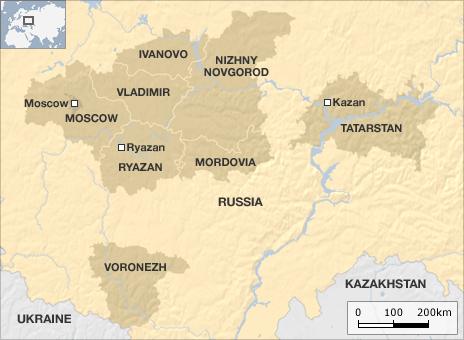Dense wildfire smog grips Moscow in heatwave
- Published
The BBC's Richard Galpin: "The smoke is absolutely choking"
The thick blanket of smog that has shrouded Moscow as peat fires continue to burn just outside the city has worsened.
The smog has disrupted air traffic at two international airports in Moscow - Domodedovo and Vnukovo.
Many Russians are wearing masks as the temperature rises close to 40C (104F).
On Thursday officials said nearly 600 wildfires were raging across a huge area of central Russia. The emergency has now claimed 50 lives.
The smog has been affecting the capital for a week, and appeared to have been easing before worsening on Friday.
Medical experts say the concentration of toxic particles in the air is far higher than the norm, and can be especially harmful to toddlers and the elderly.
Domodedovo and Vnukovo lie in the south of Moscow - areas closest to the peat fires.
Planes were still able to take off normally on Friday but incoming flights were diverted to other Moscow airports where visibility was still acceptable.
At Vnukovo visibility was reduced to 300m, and at Domodedovo it was no more than 400m.
Meanwhile, the level of CO2 in Moscow's air is more than three times higher than normal, officials say.
According to some experts, inhaling the polluted air is as dangerous as smoking several packets of cigarettes a day.
One wildfire in the Moscow region is threatening the Alabinsk military base, the RIA Novosti news website reports. More than 1,000 firefighters and two helicopters are trying to douse the flames.
Up to 2,000 homes have been destroyed in the blazes, officials say.
Seven regions are under a state of emergency. Nizhny Novgorod, Ryazan and Voronezh are reported to be the worst hit.
On Thursday Russian officials said there were 589 wildfires raging across 196,000 ha (484,326 acres). More than 160,000 firefighters have been deployed.
Forecasters expect Moscow's high temperatures to persist for several more days.
Russia has announced it is banning the export of grain from 15 August to 31 December after drought and fires devastated about a fifth of its grain crop.

- Published6 August 2010
- Published5 August 2010
- Published5 August 2010
- Published4 August 2010